The potential power of offshore wind
The Southeast coast sits at a critical precipice in the climate emergency.
We are bearing the brunt of its impacts as coastal erosion, storms, and sea level rise threaten coastal communities, yet our sunny states and breezy coastline have the potential to deliver powerful solutions and have an important role to play in addressing the climate crisis.
Our coast has tremendous offshore wind potential and is an attractive region for wind projects. An offshore wind project off the coast of Virginia — the largest approved in the nation — and other prospective projects are bringing that potential to life, and could demonstrate major Southern success in the effort to grow the renewable power industry that will propel our region forward.

In total, approved and prospective offshore wind projects have the potential to deliver up to 7,400 megawatts of clean energy to the South, enough to power over 2 million homes.
For decades, electricity generation in the South has relied on volatile fossil fuels that cause unpredictable cost spikes, pollute our communities’ clean air, and contribute heavily to climate change. With heat-trapping emissions, our region has made an outsized contribution to the climate crisis and will continue to see impacts on our most vulnerable communities, natural resources, and wildlife.
The recent release of the Fifth National Climate Assessment by the federal US Global Change Research Program highlighted the extent of what we’ve feared: impacts from a changing climate are becoming more common, and urgent action is needed to combat its momentum. Responsibly harnessing the power of the wind with offshore turbines is a vital piece to solving the climate puzzle.
Our coastline has miles of abundant wind energy potential, and our states are home to the industry supply chain and jobs that are powering our clean energy future.
Alys Campaigne, SELC Climate Initiative Leader
As waters in Virginia and North Carolina are targeted for offshore wind projects, our region has the opportunity to benefit from this carbon-free, stable, and efficient source of energy that creates jobs and strengthens the economy. SELC has been at the table with industry, federal regulators and our state and local partners to make sure that projects are developed responsibly and with adequate protection for consumers, wildlife, natural resources, and coastal communities.
“We are committed to harnessing regional offshore wind power in the fight against the climate crisis,” adds Campaigne.

But growing momentum for offshore wind is drawing fossil fuel-funded front groups out of the woodwork to stall projects and thwart the clean energy transition.
Groups that have a history of denying climate science and opposing environmental protections are now casting themselves as stewards of marine mammals. Meanwhile, scientists have found no evidence that a single whale death has been linked to offshore wind development. Instead, scientists and federal agencies have continued to call for measures to address fishing gear entanglements and vessel collisions as the largest threats to large whales.
SELC and our partners are working to ensure that offshore wind developers are using the best available science to protect migratory birds and marine mammals including the critically endangered North Atlantic right whale.
We have the policy and scientific tools to develop offshore wind right and ensure that we can take advantage of clean, abundant energy sources while protecting the coastal resources we all treasure.
Sierra Weaver, SELC Coast and Wetlands Program Leader
The Biden administration has big plans for offshore wind: by 2030, the goal is to deploy 30,000 megawatts of offshore wind energy — enough to power over 10 million homes.
Supply chain delays and price increases have slowed progress in the Northeast, but the South is making strides. In October 2023, Dominion announced that its Coastal Virginia Offshore Wind Commercial Farm is moving ahead on schedule — starting construction in May 2024 — a testament to the effort to engage multiple stakeholders in project design and locking in contracts with suppliers early in the process. It is also welcome news for regional economic development offices — major parts of the wind supply chain are located in our states. One study projects 12,000 jobs in wind-related industries in the Southeast by 2030.
“With smart siting and planning, responsible offshore wind can play a critical role in achieving a carbon-free energy future,” adds Weaver.
To continue regional offshore wind momentum, SELC and its partners are pressing Southern utilities to improve transmission planning and investment to bring more wind power to customers onshore.
Offshore wind projects on the horizon
The South holds plenty of promise for a clean energy future that tackles climate change with a clean energy portfolio that features wind. Off the Virginia coast, construction of the largest wind project approved in the country so far will begin this year.
The Coastal Virginia Offshore Wind project aims to generate power by 2026 and could provide energy for about 900,000 homes.
Approval of this project in Virginia is a strong indication for the South’s potential.
Nate Benforado, SELC Senior Attorney
In North Carolina, two proposed offshore wind projects are moving through the approval process. The Kitty Hawk project could power 700,000 homes, and the Carolina Long Bay project could power nearly 500,000. SELC has worked to ensure that both areas will include protections for the highly endangered North Atlantic right whale, whose calving grounds extend from southern North Carolina through northern Florida.

Providing a carbon-free energy source is just one of the potential benefits of these Mid-Atlantic offshore wind projects. Offshore wind energy can increase energy independence, provide a more stable and efficient means of power, and complement solar energy in a carbon-free power grid. With so many potential offshore wind sites on the table in the South, our region could see vast job and economic growth as the industry takes form.
But we need to seize these opportunities in the South while making sure offshore wind is developed responsibly and equitably so that all communities, wildlife, and natural places can benefit from the possibilities and avoid possible impacts.
Adds Benforado, “We hope wind continues to move forward here to shore up our defenses against a changing climate, bring new, clean energy jobs to our communities, and meet our carbon reduction goals.”
With longstanding expertise in energy law and policy, leadership on coastal protections, and feet planted firmly in the South, SELC is taking the urgent climate action we need.
